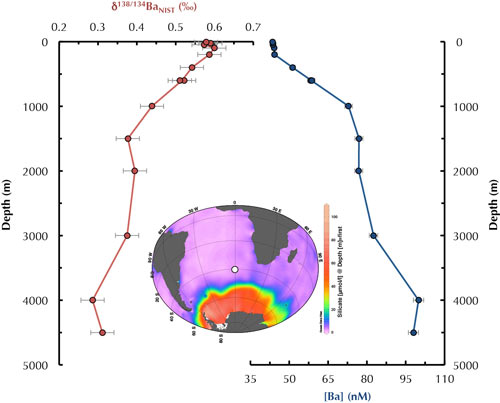New insights into global barium cycling from the first barium isotope data for seawater
A new method developed by Horner and co-workers (2015, see reference below) allows for the determination of dissolved barium (Ba) isotopic compositions in seawater using nanogram quantities of Ba.
The formation of BaSO4 (barite) in open ocean seawater is largely driven by the microbial remineralization of sinking organic matter. By analysing a 4500 m depth profile of Ba-isotopic compositions from the South Atlantic, Horner et al. find that BaSO4 precipitation removes isotopically light Ba from seawater, which renders residual, Ba-depleted seawater with heavier Ba-isotopic compositions. The distinct patterns of Ba isotopic variation in the deep ocean are clearly related to the mixing of distinct water masses formed at higher latitudes. These data indicate that water masses obtain their Ba-isotopic signatures when at or near the near-surface, and that regional circulation exerts a strong control over Ba-isotopic distributions in the South Atlantic, and possibly elsewhere.
More broadly, these new data point to several important linkages between C remineralization and the Ba cycle, suggesting that Ba-isotopes may develop into a powerful new means to study marine biogeochemical cycles.

Figure: Horner et al. present the first Ba-isotopic analyses of seawater for samples collected as part of UK GEOTRACES from the South Atlantic (GA10E/D357; see inset for location). The profile shows substantial Ba-isotopic variation (left) that correlates with the major changes in Ba concentrations (right). The concentrations and isotopic data reflect a combination of both barite cycling in the shallow subsurface and large-scale oceanic circulation.
Reference :
Horner, T. J., Kinsley, C. W., & Nielsen, S. G. (2015). Barium-isotopic fractionation in seawater mediated by barite cycling and oceanic circulation. Earth and Planetary Science Letters, 430, 511-522. http://dx.doi.org/10.1016/j.epsl.2015.07.027 Click here to access the paper.
